There are many ways of flooring a home recording studio. Some of them are easy to install, while some are not and may require a heavy investment. We will look at the different ways to achieve the ambiance we want from our flooring for recording. I will be discussing each choice of flooring and what you need to know regarding the acoustic properties. It will be easier for you to choose among them based on your situation and recording purposes, whether for a video or music studio. It will mainly depend on the amount of budget you can put into it.
So what is the best flooring for home recording studios? The best recording studio floor is hard flooring. Hardwood, tiles, or concrete are good examples. You should avoid using carpets because they wear out from high foot traffic and absorb high frequencies, which messes up with the acoustics.
In this ultimate guide, I will try and help you get clarity with the different options and tell you my thoughts on what I think are the 4 best floorings for recording.
Before we come to that part, we will discuss some important factors to consider to be a better judge when choosing to floor for recording.
Hard flooring is desirable. It is the ideal choice for recording music, according to professionals. If the aesthetics did not matter, concrete would be ideal due to its reflective nature. On the other end of the spectrum, the carpet would be most discouraged. Soft flooring like carpet often provides poor acoustic properties.
The aesthetics of the flooring is to be considered. Concrete would be ideal but might not give you the most welcoming feel.
Price is what you pay; value is what you get. Ultimately, a choice of flooring may be the best but discussing the option may be redundant if it is beyond your budget. The size of the room will be a major factor in determining your budget.
Best Flooring for Recording Studios
Here is a brief overview of the 4 best flooring for home recording studios:
| Properties | Hardwood | Cork | Laminate | Vinyl |
| Price per square foot | $5 to $20 | $5 to 14 | $3 to $8 | $1 to $4 |
| Durability | Excellent | Somewhat Poor | Good | Good |
| Hardness | Very Hard | Somewhat Soft | Somewhat Hard | Somewhat Hard |
| Installation | Somewhat Easy, Recommend Professional Support | Somewhat Easy, Recommend Professional Support | Easy, Do It Yourself | Somewhat Easy, Do It Yourself |
| Cleaning and Maintenance | Very Easy | Somewhat Difficult, may require replacement | Somewhat Easy | Somewhat Easy |
| Comfort for Long Duration Standing | Somewhat uncomfortable | Very Comfortable | Comfortable | Comfortable |
| Insulation | Poor | Excellent | Average | Good |
| Acoustic Properties | Reflective of Most Frequencies | Warmer sounds | Great Sound Insulation | Great Sound Insulation |
1.Hardwood Flooring :
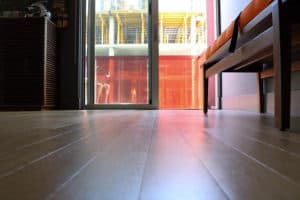
It is the most common type of flooring that you can see in most professional music studios. It will be a bit expensive compared to some others, and you will need professional support to install it.
If your room already has a thick hardwood floor, then you don’t need to replace or do anything fancy with the floor. You may need to add some rugs here and there under your equipment.
Its moisture absorption qualities are excellent and repel water very well. It can be somewhat of a pricey option as it can cost anywhere between $5 to $20 per square foot. To be installed by a professional, you are looking at the $20 per square foot’s upper end.
On the other hand, even though it is the pricier flooring type, you will be saving on cleaning and maintenance due to its hardness and durability in the long run. It is easy to clean, and you will have a lower chance of replacing the tiles.
Adding the rugs or any other additional piece like foams inside the room will depend on factors such as the thickness of the wood, the layout, the ambiance of your studio room, the amount of dryness you want, etc.
Hardwood flooring’s acoustic properties give the sound a natural feel by reflecting most soundwave frequencies. You can make the waves reflected from the floor to balance out with the absorbers and diffusers inside the studio.
Its hardness makes it somewhat less of a comfortable option if your recording purposes involve standing for long hours. You may consider appropriate seating where necessary.
This resultant sound will also depend on the process of acoustic treatment you do with your studio.
So, it would help if you did it properly to get the best out of it. If you neglect this part, then having a hardwood floor will negatively affect a positive one.
If you already have hardwood flooring and get many echoes, find out in this article about how to reduce echo in a room with hardwood flooring.
2.Cork Flooring :
You must have come across this one too and heard about it quite a lot. You maybe even be thinking about doing this.
Cork flooring can generally cost anywhere between $5 to $14 per square foot.
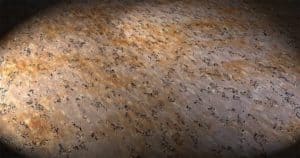
There are pros and cons that you need to consider with this type of flooring. Naturally, it has sound-deadening properties.
And thanks to these sound-deadening properties, it is widely used as flooring material inside studios. Besides using it as a flooring material, it can also be used as a subfloor under another material type.
This is done so to act as a decoupling material between the two adjacent layers or floors. It will help in preventing the transfer of vibrations from one layer to another.
The sound waves’ reflection will be much lower than hardwood floors; it will give off warmer sounds. I have seen many studios using cork flooring in control rooms.
It is good with the feet and suitable for standing long hours due to its ability to absorb pressure. Don’t forget to seal the floor properly and check once in a while as it is not as waterproof in nature as the other options for a recording studio floor. Implementing a protective coating to cork will improve its water resistance.
The cork’s unique properties seem to be highly affected by the changing temperature and humidity, so it may be important to control temperature and humidity within the room. This can easily be solved by keeping a cheap dehumidifier in the studio. If you want to keep the cork hard, you ideally want to keep the room cool enough but not so cool that it impacts any vocal performers’ performance.
The con is that it is not that durable, and you will see many others turn down cork flooring due to this factor. It is expensive too, in the same price range as hardwood floors. They are vulnerable to dimples and dents from equipment.
Check out my article about the Best Flooring Types For A Drum Room.
3.Laminate Flooring :
Laminate flooring is a popular choice and a good flooring type that you can find pretty much everywhere. You can use this type of flooring for most types of purposes.
Laminate flooring is a cheaper option for recording studio floors costing from $3 to $8 per square foot.
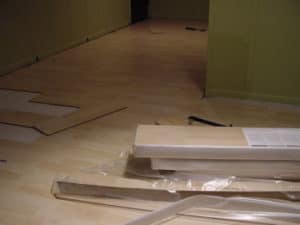
 e
e dia Commons
dia Commons
They are known as floating floors as they don’t need any nailing or gluing to the subfloor.
It is made up of different materials by fusing them, so it is a multi-layer product. Laminate flooring is quite popular nowadays due to its advantages over others.
Laminate floorings are easy to install, and you don’t need any expertise to do a good job on them. The best part is that it is not expensive as compared to other types of floorings.
I can say that this flooring will come at the top 3 when we choose the type of flooring for a home recording studio.
The advantages are its durability, lower price range, ease to clean and maintain, install, a wide range of colors and styles, water-resistant.
It won’t reach the kind of reflections that you get from a hardwood floor for a home studio, and the warmth won’t be much compared to the latter.
But, it will do quite well compared to other counterparts. Well, you can’t compare an expensive one with a cheap one.
You will be getting a bang for the price range you are paying for flooring your home studio. You can definitely go with this if you want to save some bucks.
If you want to know more here is an article on the price of different floors and their installation cost.
4.Vinyl Flooring :
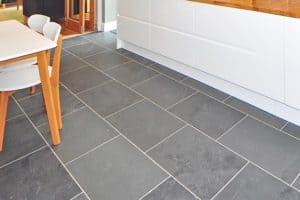
It is another type of flooring that uses artificial material. I have seen studios using this type of flooring and it handles the traffic inside the studio very well.
It is also known as tile flooring.
The price can go from around $1 to $4 per square foot, depending on the appearance and texture that you are opting for. This makes vinyl the cheapest option for recording studio flooring.
There are two main methods by which vinyl tile floors can be made: Inlay Vinyl Tile and Rotogravure.
Inlay Vinyl Tile is the most durable of the two methods and is made to allow the floor to go through to the backing. The durability comes from being manufactured with multiple layers of vinyl.
The Rotogravure process involves printing the design with vinyl ink onto a mineral felt backing often coated with a wear layer. The protective coating is there as an attempt to improve its durability.
The pros of vinyl flooring are that it is durable, water-resistant, easy to clean, somewhat scratch-resistant to some extent, and it also comes in a wide range of colors and textures that you can choose from. On the other hand, they are vulnerable to dimples and dents from equipment. Vinyl flooring is generally better in the domain of resistance against water and durability.
Vinyl tiles can also insulate well from heat and sound. These are the main reasons why it is used in studios.
It is also very affordable and has the same price range as laminate floors.
The performance part depends on various factors such as how you install it, what type of sub-floors you have, the type of treatment you have done or will do.
Your room/studio will respond very differently depending on these factors. You can test it out after finishing and see where you can make it better.
Looking at the price for installing it at your recording studio, it will be a green light from me.
For more information, check out what floating floors are and whether they’re good.
Other alternatives worth mentioning
Concrete flooring
Concrete flooring would actually be the ideal choice for durable flooring options and a hard reflective surface. The biggest problem is that you probably would consider it pleasant for the studio, and you are unlikely going to get concrete flooring within a house unless it was a basement or a garage.
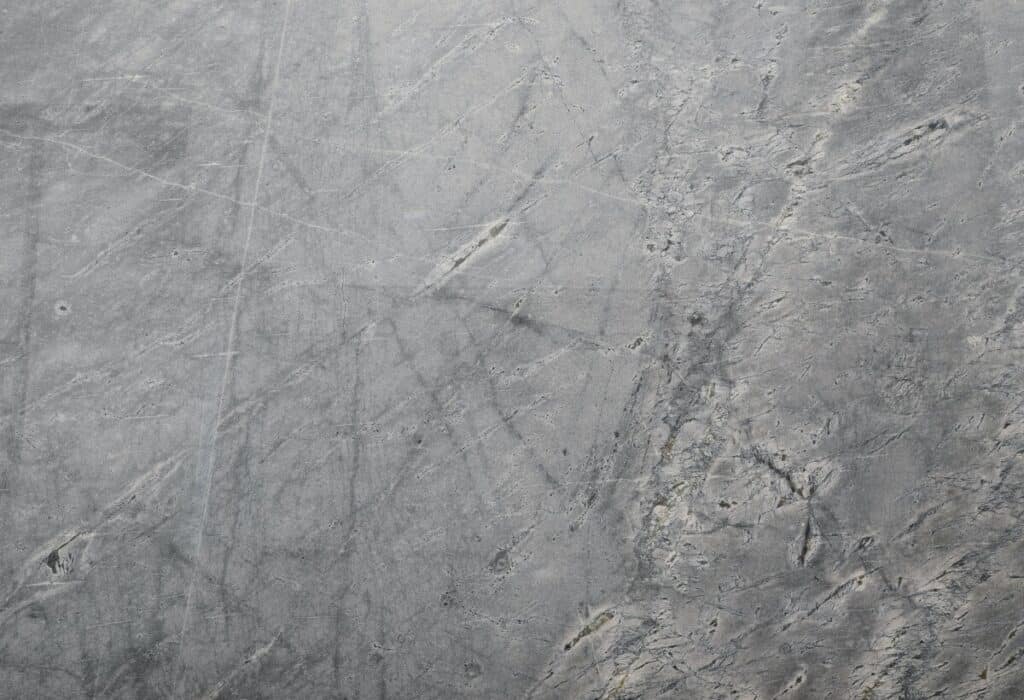
Along with not being aesthetically pleasing to the eye, it also would not be suitable for long durations of standing.
Carpet flooring
Carpet flooring would be an example of the least desirable flooring for home studio recording purposes. This example of soft flooring attenuates and absorbs medium and high-frequency soundwaves but, at the same time, reflects low-frequency soundwaves. This gives carpet poor acoustic properties.
On top of that, it wears out very quickly and holds a lot of dirt and dust, making it difficult and expensive to clean and maintain and worsen the acoustic properties.
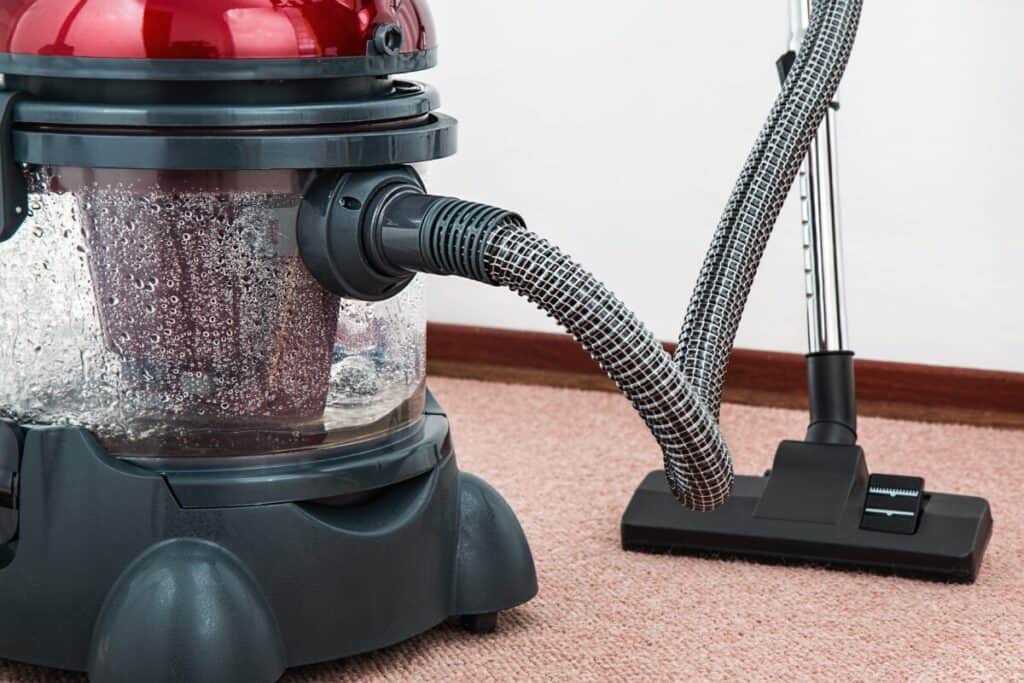
For more information, check out my article:
Porcelain and ceramic tiles
Porcelain and ceramic tiles can be a useful alternative and most certainly better than carpet. They do offer the hardness that supports the reflection of most sound frequencies. Porcelain and ceramic tiles would not be a cost-efficient choice of flooring, nor are they the most durable as the involvement of moving heavy objects, including large kits or instruments, may risk breakages of the tiles.
Fixing or replacing porcelain or ceramic tiles would be incredibly difficult, especially when it comes to the removal of the individual tiles. This would include a considerable amount of manual labor of chipping away the sealant and broken parts of the tiles, not to mention the mass clean up requirement.
What is the Best Flooring for a recording studio?
It will come down to how much of a budget that you can invest in it, plus what you will get out of it.
In my opinion, I would go with the hardwood flooring or laminate flooring. Considering everything that I could think of, these two will be the best for studio flooring, among the others.
You can go with hardwood floors if you have the money for it, or you could settle for the laminate floors if you don’t have a big budget. You can still manage pretty well with laminate too.
If you are looking to record a live band in a room
, find out more in this article.
How to install the floors?
You can do it yourself if you want, but I think it will be best to hire someone to handle the installation of something like hardwood floors.
As it is an expensive one and you won’t want to mess it up. Don’t cheap out on that part if you are going to install expensive ones.
If you are going to install it yourself, you will need to research how to do it properly.
You don’t want to miss out on something like adding a sub-layer before installing the laminate floors to deaden sounds, keeping spaces for expansions, etc.
There are small but important things that go into while flooring a studio. So, make sure you are covering the portion properly.
There are other flooring types, too, but I have mentioned only some of them, which are common and suitable for studio flooring.
I will update it if there is anything more 🙂
Want to Setup your Home Recording Studio Under 400$ or 1000$! Then you can Learn More about Some of the Best Setups for different price ranges
we have prepared for you!
Final Thoughts
As well as the flooring, it is also important to take into consideration the walls too. You will need to choose the right material for your wall as it contributes a lot to your studio’s soundproofing.
Make sure you look long term and take a bigger perspective of investing in your home recording studio. Using a budget and drawing up a hierarchy of importance will be necessary to not overspend on flooring and sacrifice in other aspects.
Check out my article on Tips for Making Studio Quality Recordings at Home
Recent Posts
QuickTime is a vital app for many Mac users, and if you’ve recently bought a new microphone, you might wonder how to use it optimally. QuickTime cannot record audio content if it doesn’t have...
Every microphone leaves a unique signature on the quality of its output. If you’re a podcaster trying to melt your way into your audience’s hearts, a muddy, distorted recording won’t cut it....
